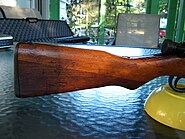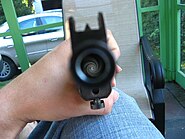| Type 99 rifle | |
|---|---|
|
File:Type99Rifle.JPG A Type 99 Long rifle without monopod. | |
| Type | Bolt-action rifle |
| Place of origin |
|
| Service history | |
| In service | 1939–1945 (Japan) |
| Used by | Users |
| Wars | Chinese Civil War, Second Sino-Japanese War, World War II, Soviet–Japanese Border Wars, Korean War, Vietnam War, Indonesian National Revolution |
| Production history | |
| Designed | 1939 |
| Produced | 1939–1945 |
| No. built | ~3.5 million [1] |
| Specifications | |
| Mass | 8.16 lb (3.7 kg) |
| Length | 44.1 in (1120 mm) |
| Barrel length | 25.87 in (657 mm) |
|
| |
| Cartridge | 7.7×58mm Arisaka |
| Action | Bolt action |
| Muzzle velocity | 730 m/s (2394 ft/s) |
| Feed system | 5-round internal box magazine, stripper clip loaded |
The Type 99 rifle Arisaka or Type 99 short rifle (九九式短小銃 Kyū-kyū-shiki tan-shōjū) was a bolt-action rifle of the Arisaka design used by the Imperial Japanese Army during World War II.
History[]
During the Second Sino-Japanese War in the 1930s, the Japanese soon found that the 8×57mm IS cartridge the Chinese used was superior to the 6.5×50mm cartridge of the Type 38 rifle, necessitating the development of a new weapon to replace the outclassed Type 38.[2] The Imperial Japanese Army (IJA) developed the Type 99 based on the Type 38 rifle but with a caliber of 7.7mm. The Type 99 was produced at nine different arsenals. Seven arsenals were located in Japan, with the other two located at Mukden in China and Jinsen in Korea.
The IJA had intended to completely replace the Type 38 with the Type 99 by the end of the war. However, the outbreak of the Pacific war never allowed the army to completely replace the Type 38 and so the IJA used both rifles during the war. As the war progressed, more and more cost saving steps were introduced in order to speed up production. Late war rifles are often called "Last Ditch" or "Substitute Standard" due to their crudeness of finish. They are generally as crude as the 1945 dated Mauser K98k of Germany, or worse.
The Type 99 was produced in four versions, the regular issue Type 99 Short Rifle, the Type 99 Long Rifle (a limited production variant) and takedown Type 2 Paratroop Rifle and the Sniper Rifle Type 99. The standard rifle also came with a wire monopod and an anti-aircraft sighting device. The Type 99 was the first mass-produced infantry rifle to have a chrome lined bore to ease cleaning. All of these features were abandoned by mid-war.
A Type 99 Short rifle made after mid-war (also known as the Type 99 "last ditch" rifle). The rifle has no flip-up anti-aircraft rearsight nor monopod.
Other users[]
During the Korean War, approximately 126,500 short and 6650 long Type 99 Rifles were re-chambered under American supervision at the Tokyo arsenal to fire the then-standard .30-06 Springfield cartridge. "Apparently" intended for the South Korean gendarmerie, few rifles appear to have been issued at the end of the war in 1953. These rifles were fitted with a lengthened magazine well and had a small notch cut in the top of the receiver to accommodate the .30-06 round's 1/3 inch greater length.[3] Accuracy suffered, due to the difference in cartridges, rifling rate and characteristics, but they were nonetheless functional. Conversions to both .30-06 and 7.62 NATO have also been performed by civilians, often along with sporterising modifications.
After 1946, the Republic of China re-chambered large amounts of Type 99 rifles to fire the 8×57 IS cartridge.[1] Indonesian forces used a large amount of Type 99 rifles in the fighting against the Dutch during the Indonesian National Revolution (1945–1949). The Royal Thai Army received Japanese rifles of all types after 1945 and converted some short Type 99 rifles to fire the U.S. .30-06 cartridge during the early 1950s.[3]
Design[]

The Flip-up Anti-aircraft rear sights of a Type 99 rifle. The calipers on the sides are to determine the speed of the targeted aircraft.
The Arisaka was based around the basic German Mauser design, albeit with some local alterations. It utilized a cock-on-closing action, which improved the rate of fire from the standard Mauser cock-on-open design. Also unique is the rifle's safety mechanism, operated by pressing in the large knurled disk at the rear of the bolt with the palm of the hand and rotating it in a 1/8 clockwise turn, which is often misunderstood by Western shooters who are used to the Mauser's thumb lever safety. It featured a quick-release bolt and antiaircraft sights, as well as a rotating bolt cover and monopod. The bolt cover, in particular, was highly problematic. Many soldiers simply discarded them due to excessive rattling. As a bolt action rifle, the Type 99 was a very solid weapon, but as with all manually operated rifles used during World War II, they were in most close combat situations outclassed by semi-automatic rifles and submachine guns.
The Type 99 is one of the strongest military bolt rifles ever made,[4] but many late-war ("last ditch") rifles used lower quality parts, and a complete lack of finish, as well as shortcuts taken to ease production. The "last ditch" rifles are usually distinguished by their crudeness; poorly finished stock, wood buttplate, very obvious tooling marks in the metal, rudimentary sights and an unfinished bolt knob and handle. Such late war rifles may be unsafe to fire.
In some cases, these rifles may actually be training rifles intended for firing blank cartridges only. The training rifles were made of mild steel and were never intended for ball ammunition. It is possible that reports of Type 99 rifles blowing up were simply the results of soldiers testing captured weapons. Unaware that they were using drill rifles, they fired ball ammunition in them with poor results and possible injuries. It is possible that this may have unjustly led to the Arisaka having a reputation (at least for the last ditch rifles) for being of poor construction.
The Type 99's bayonet was in the form of a very long, slender blade, grooved to reduce weight. The early models featured a hooked quillion. These bayonets attached to a lug under the barrel and were further stabilized by a loop that fit around the muzzle. Unmounted, it handled like a machete.
Gallery[]
Availability[]
Though the Arisaka rifle was never exported to the USA in great numbers, there are many thousands available—most having been brought home by Marines and soldiers returning from the Pacific theater. In many cases, the imperial chrysanthemum atop the receiver has been defaced by the surrendering Japanese in order to preserve the Emperor's honor: the mark indicated that the rifle was the Emperor's personal property. Rifles with an intact chrysanthemum bring a premium on the collector market, sometimes almost double the price for a like model defaced rifle. Many have been rechambered to more common calibers, due to the relative scarceness of factory 7.7×58 Arisaka, unlike other rifles of the period, it is particularly suitable because of its strong, safe action.
Users[]
 National Revolutionary Army: re-chambered for the 8×57mm IS cartridge after 1946[1]
National Revolutionary Army: re-chambered for the 8×57mm IS cartridge after 1946[1] Chinese Red Army
Chinese Red Army Indonesia: used during the Indonesian National Revolution[3]
Indonesia: used during the Indonesian National Revolution[3] Empire of Japan
Empire of Japan North Korea: during the Korean War[5]
North Korea: during the Korean War[5] South Korea: few were actually issued [3]
South Korea: few were actually issued [3] Thailand: used after 1945, some were converted to the .30-06 cartridge in the early 1950s[3]
Thailand: used after 1945, some were converted to the .30-06 cartridge in the early 1950s[3] Vietnam: Used by Viet Minh soldiers in the First Indochina War
Vietnam: Used by Viet Minh soldiers in the First Indochina War
References[]
- Hatcher, General Julian S. (1966). Hatcher's Notebook. Harrisburg, PA: Stackpole Company.
- ↑ 1.0 1.1 1.2 Walter, John (2006). Rifles of the World (3rd ed.). Iola, WI: Krause Publications. p. 33. ISBN 0-89689-241-7. http://books.google.com/books?id=Eq2Dnj4sDZIC&pg=PA33.
- ↑ Military Factory - Arisaka Type 99 Rifle
- ↑ 3.0 3.1 3.2 3.3 3.4 Walter, John (2006). Rifles of the World (3rd ed.). Iola, WI: Krause Publications. p. 34. ISBN 0-89689-241-7. http://books.google.com/books?id=Eq2Dnj4sDZIC&pg=PA34.
- ↑ Hatcher, P. 206, 210
- ↑ Edwards, Paul M. (2006). The Korean War. Westport, CT: Greenwood Press. p. 77. ISBN 0-313-33248-7. http://books.google.com/books?id=xA34hGXAjlIC&pg=PA77.
External links[]
| Wikimedia Commons has media related to Type 99 rifle. |
| ||||||||||||||||||||||||||||||||||||||||||||||||||||||||
The original article can be found at Type 99 rifle and the edit history here.







